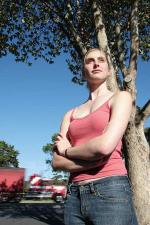Keeping our trees streets ahead
 Environmental Biology Environmental Biology
Adelaide's unique street tree environment is a haven for our birdlife - but more needs to be done, according to a University of Adelaide researcher. Karen Young (pictured right) studied hundreds of street trees in Adelaide for her Honours project in the School of Environmental and Earth Sciences to find out what type of birds used them and what factors influenced this use. "We have quite bit of vegetation on our streets, which means a number of birds can use street trees and the ground for food and shelter," she said. "In other cities which are much more built-up, like London, birds don't have this luxury - they can feed only on the ground." But to preserve this uniqueness, Karen said, it is not simply a matter of planting more trees, as a wide number of factors affect how birds use street trees. "I looked at four main species of trees that are common in Adelaide, and what birds used them for: the native red gum, plane trees, jacarandas and bottlebrushes," she said. "Out of the 45 species of birds commonly seen on the Adelaide plains, I counted 28 different species during my survey. Of those 28, I saw 24 species actually using the trees. Some species of birds were quite common, like the noisy miner, and others were seen only occasionally, such as the red-rumped parrot and silver-eye. "Different birds used the trees for different reasons, and some trees were better than others in certain ways. Plane trees and red gums were good for food, where the jacarandas weren't. Birds that used hollows for sheltering liked the red gums and plane trees, and the birds that used nests liked the bottlebrushes. "Season also influences which birds are using which trees and when, because they affect the resources the trees provide: once the bottlebrushes stopped flowering the rainbow lorikeets stopped using them, and little wattlebirds were generally only seen using the red gums in summer." Adelaide residents also have a big part to play in maintaining an overall bird-friendly environment. "Although tree species and season are very important, an interesting finding from my study was that the surrounding environment in which the street trees stand affects how the tree species and season influence the birds," she said. "Essentially, that means how well-vegetated the front gardens are along the street. A single tree surrounded by concrete is less likely to attract great numbers of birds if the little bit of food or shelter that tree provides are the only things in
the area, no matter how good that tree species may be elsewhere. "But if you have gardens with a variety of vegetation, like some lawn, shrubs, and ground covers, then birds are more likely to be in the area. "Birds are then more likely to use the street trees if the tree species and time of year are appropriate, as these are most important factors for them. "Councils do have a big part to play in what street trees go in where, and they have a lot of things to consider: how long the trees are going to last, how much will they cost to maintain, how much shade they will provide, and how much they will cost
to replace. "But I hope my study will show that with just a little bit more thought about what trees are effective and where and when they are effective, councils can use them more appropriately. Part of it is also up to us, to make sure we provide the appropriate surrounding vegetation to create an environment where birds are encouraged to use our street trees as much as possible." Story by Ben Osborne
|





